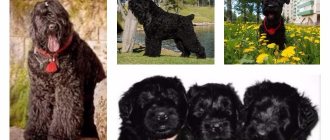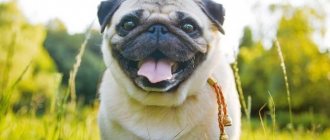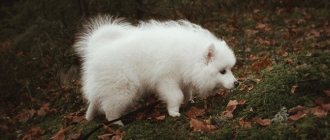Appearance of the Black Russian Terrier
General impression
As you can see in the photo, the Black Russian Terrier has a large, muscular, harmoniously built body and a noble, aristocratic appearance. The breed, bred in the Soviet Union, has gained worldwide recognition due to its high intelligence, excellent working qualities and ideal adaptability to extreme environmental conditions.
Head
The head is round and compact; on the muzzle, thick hair forms a mustache, beard, and eyebrows. The head size of the Black Russian Terrier is slightly more than 40% of the height of the withers.
The lips are closed tightly, the nose is round, large, and black. The ears are set high, adjacent to the cheekbones, without creases or folds.
The dark eyes are medium in size, oval in shape, set wide apart. The jaws are strong, the bite is scissor-shaped, the teeth are strong and fit tightly to one another.
Neck
Strong, medium, muscular. The transition line to the body is smooth, at an angle of 45°.
Torso
Slightly elongated, the chest is oval, strong and wide, the stomach is tucked. The flat back does not have a bend in the middle. The short loin is convex.
Front and hind limbs
The front legs are medium and strong, located parallel to each other. The forearms are set vertically, the elbows are directed back. The hock joints are well defined.
Long shins, femurs are located at an angle, phalanges of the fingers are collected compactly.
Tail
Saber-shaped, thickened at the base. In the Russian Federation it is usually stopped. But natural length is not a disadvantage of the breed.
Movement
A sweeping, energetic trot with a wide stride of the front legs is possible after a strong push from the hind legs. The strength of the push is determined by the strength of the muscles, the strength of the ligaments and the correct structure of the body as a whole. Thus, a black cat with a square-shaped body is able to move in a balanced manner, but with a small step amplitude.
Wool
A purebred dog's body is covered with thick hair of 2 layers: dense short undercoat and coarse guard hair 6-14 cm long with a break. The head and paws are necessarily decorated with pile in the form of “whiskers”, “eyebrows”, “pants”.
The breed standard allows for small curls on the chest, side, and back. Hair at a young age is more dense, soft and shiny, but over time it turns pale, breaks, and becomes tougher.
Black Russian Terrier colors
Acceptable color is completely black and with slight graying (the light percentage of hair makes up no more than a third of the surface of the body).
Dimensions
Males in adulthood reach up to 75 cm at the withers, females - up to 73 cm. A deviation of 3 centimeters is considered normal in the growth of the Black Russian Terrier. Sometimes it can be large, but provided that the dog has ideally preserved body proportions.
The weight of the Black Russian Terrier reaches 72 kg, females weigh a little less - up to 52 kilograms.
Description of the breed
Blackies are large, tall dogs with powerful bones and strong muscles. Their body is tightly covered with skin that does not form folds or sagging. RCTs are distinguished by their natural malice and distrust of strangers, while the dogs are perfectly trainable and can live in any climatic conditions, working as watchmen, acting as a companion, etc. The breed is characterized by mobility, a balanced character, and a developed defensive reaction.
Appearance
Bred for service work, the RCT is an athletic, large, reliable dog. The constitution of the breed is strong, the height of males varies between 66-72 cm, weight is 50-60 kg, females - 64-70 cm with a weight of 45-50 kg. The bones of the animal are large and strong, the head is proportional to the body, and the length is equal to the neck. Dogs with Newfoundland ancestry have short hair, while the body of the rest is covered with long, dense hair.
Breed standard
RCT is one of the few breeds whose gene pool includes a large number of the best qualities of other dogs. More than 15 breeds were involved in the creation of blackies, whose characteristics best satisfied the needs of breeders. According to the standard, RCT should look like this:
- General form. Massive bones, developed muscles, proportional build, average height - 71 cm at the withers.
- Head. The cheekbones are rounded, the skull has an elongated shape, tapering towards the muzzle. The dog's brow ridges are hidden, the forehead is flat, and the transition from it to the muzzle is barely noticeable. The black terrier has a mustache and beard made of wool; its nose is large, expressive, and dark in color. Pigmented deposits are visible on the gums.
- Ears. They hang from the cartilages, but are set high. The classic version is a triangle, the edges of which are adjacent to the cheekbones. The hanging part of the ears has no folds or indentations.
- Teeth. The incisors are arranged in one line, the bite is scissor-shaped. The dog has 42 teeth in total.
- Eyes. Oval in shape, widely set, dry eyelids, tightly fitting to the eyeballs.
- Neck. Same length as the head. It is massive.
- Frame. Deep, wide chest line with prominent ribs. The lower part of the body is located at the level with the elbows. The withers are well developed and stand out sharply. The dog's loin is relatively short, convex in shape, the croup is medium-long and wide.
- Paws. Black terriers have long, straight, rounded limbs. The claws are dark. The shoulder blades are set at the correct angle. The shoulders are of medium length, set parallel and vertical. The hips are wide, the legs vary in length, and the hock joint is clearly defined.
- Tail. Traditionally, it is stopped at the level of the 3rd vertebra. The tail of the RCT has a thick base and is set high.
Coat and color
The dog's coat has a break of approximately 6 cm, the texture of the coat is rough. Decorative hair (mustache and beard) is pronounced in RCT. To ensure good thermal insulation, the animal has a soft undercoat. The breed has an exclusively black coat, but small patches of gray are acceptable. Sometimes puppies' black fur turns brown or gray at 2-3 months, which can be due to various factors, including hormonal changes or genetic inheritance.
- 6 ways to maintain personal space and well-being
- French for short nails
- Fish soup
Personality of the Black Russian Terrier
The Black Russian Terrier is a responsible, fearless, angry watchman and bodyguard and a devoted friend with a strict character at the same time. Animals easily and quickly get used to the role of pets and get along well with other animals and small children.
Service dogs exhibit a fair amount of distrust and suspicion of strangers, but they are in no hurry to start a dog, preferring to once again make sure that there is a real threat.
Blackies attack when they feel that someone is encroaching on the safety of their owner. At the same time, they will never tear the clothes, arms and legs of the aggressor. The animals’ task is to scare the potential “offender” and force him to retreat.
The Black Russian Terrier greets random guests with a loud bark, nothing more. But he definitely won’t jump and caress happily either. The supply of tenderness and dog love is limited, and the dog will give it not to casual acquaintances, but to family members.
You can completely entrust the animal with the protection of private property, a house and an entire estate. The dog carefully examines every corner and will not allow a single living soul into the entrusted territory. Many breeders of the breed note that the blackie has a vindictive disposition.
Indeed, animals have excellent memory, but this does not mean that only evil is remembered - the dog also remembers pleasant moments all his life. Despite their peaceful and kind nature, dogs are very proud: they sincerely love and respect their owner, but will not allow themselves to be made into a “circus performer” bringing slippers and newspapers.
In general, the character of the Black Russian Terrier is reserved and docile; the dogs will happily play with small children and will take responsibility for protecting their owner’s property. By nature they have a perceptive mind; by their facial expressions and intonation in their voices, blacks are able to understand the mood of people. And if it is bad, then the dog will never impose itself, but will go about its business.
Russian terriers also get along with other pets, but only when they do not see them as rivals. It is better if the second pet in the house is a small decorative dog that does not pose a threat to the blackie’s pride.
History of the origin of the breed
The Black Russian Terrier breed is often called "Stalin's dog." And all because it was developed in the post-war years in the USSR during his reign. During the war years, a lot of service dogs died, and during this time the country was filled with “traitors to the motherland,” prisoners of war and other prisoners who needed to be protected. In order to increase the number of guard dogs, in 1949 the Ministry of Defense issued an order that obliged to restore the number of such dogs, as well as to develop a new breed. This should be a breed of strong and hardy dogs that could serve in any climatic conditions, impeccably obeying the owner-guide.
They should be easy to train and unpretentious in food and maintenance. This task was assigned to the Krasnaya Zvezda nursery near Moscow. The Giant Schnauzer was taken as the main breed, to which 17 more breeds were subsequently added, which were available at the nursery at that time. The black terrier has the blood of a diver, Rottweiler, Great Dane, East European Shepherd, St. Bernard, Caucasian Shepherd, Airedale and other breeds.
The first 43 copies were presented at the All-Union exhibition in 1957. The bred breed group met all the requirements, but the dogs became very attached to one owner, which was not suitable for service in special forces. It was decided to continue the selection and give the resulting representatives for breeding to other nurseries in the country and to private individuals. In the 70s, the black terrier already took part in international exhibitions, and in 1981 the breed group was developed into a separate breed. The dogs received worldwide recognition and FSI approval in 1984. In the same year, the first standard was adopted, which was amended in 2010. Stalin's dog is popular not only in Russia, but also far beyond its borders, and its low price makes the breed accessible to a wide range of admirers of large dogs.
Education and training
Large guard dogs are a big responsibility for the breeder, since others perceive the animals as potential “killers” and treat them with great caution. For this reason, raising a dog needs to be taken seriously, and it is better to entrust this to a professional dog handler. Remember, you can raise an obedient and calm dog and a vigilant watchman from a baby - it all depends on the training method.
Don’t forget about the leadership traits of the black cat: dogs certainly cannot be properly raised by elderly and inactive people, whom they see as a “lower caste.” The Terrier needs a fair and strict teacher who will treat the animal with respect and constantly demonstrate “who’s boss.”
Taking into account the peculiarities of psychology and temperament, it is possible to make a diligent student out of a dog. Thus, in the training of a guard breed, repeated repetition of the same command is not acceptable. The dog will fulfill the requirements several times, after which it will begin to ignore the teacher. And it's not a matter of stubbornness, but self-esteem.
You should not shout or scold your dog if, before executing a command, it thinks for a long time - “Measure 7 times, cut 1” - this is about the Russian Terrier. Be patient and attentive.
You can train little ones even in adulthood, but be prepared for the fact that the learning process will be much more difficult, and it will not be possible to correct the mistakes made. It is better to do this from an early age, and in their free time, playful and restless puppies need to be constantly occupied with something. Let them be rubber squeakers, bones and other safe toys - so the shoes and the interior of the house will not be damaged.
When raising and training a Black Russian Terrier, you should not:
- Using “No!” commands too often and “Ugh!”, making life as a pet a total no-no.
- Encourage your baby to engage in active games and provoke him to bite his arms and legs.
- Tug on a rag or toy with a teenager and a puppy whose bite has not formed.
- It is rude to punish a dog for misbehavior by taking away food and favorite items.
Every correct action should be rewarded with praise and petting. You can buy treats at a pet store or prepare them yourself.
Mischievous actions must be stopped immediately, but it is important to do this correctly. You cannot hit a dog with your hand - the Black Russian Terrier should not associate the owner's hand with a threat. It is better to lightly hit a guilty pet on the back with a newspaper or rolled up towel.
It's even better to use punishments that the puppy understands genetically. So, you can press the baby to the floor for a few seconds, lift it by the withers and lightly shake or squeeze your fingers, demonstrating a “bite”. This is how a mother dog raises babies.
To judge an adult black dog, it is enough to raise your voice or change your intonation - dogs perfectly sense a person’s change in mood and understand that they have done something wrong.
At the age of 1.5 years, it is recommended to take a general course of training with a teenager on the playground to reinforce correct behavior. To do this, it is better to use the help of an experienced specialist, since mistakes made in education will be very difficult to correct. Blackies have a phenomenal memory, remember lessons for the rest of their lives and cannot be relearned.
After OKD, you can start ZKS - of course, if you want to raise a watchman. Otherwise, the general course will be more than enough.
Cocktail “Dirty Black Russian”, recipe
This recipe will appeal to cola lovers: it is unclear why cola in the composition becomes synonymous with dirt, but you can’t erase the word from the song. So.
Ingredients
- Vodka – 50 ml
- Coffee liqueur – 20 ml
- Cola - to taste
Preparation
Add ice, vodka and coffee liqueur to the glass. Stir gently and add cola to taste.
Keep in mind: mixing good coffee liqueur with cola is a sin. Coke can be used to flavor cheap liquor, or if you want something simple and sweet.
And in conclusion - a little magic, of course, black and Russian folk.
Health and diseases of the Black Russian Terrier
By crossing different breeds of hunting and service dogs, breeders managed to obtain a hardy, intelligent, strong individual with a strong immune system. Blackies have practically no genetic diseases, but, like other pets, they have some health problems.
Possible diseases
Rare hereditary disorders in Black Russian Terriers include:
- abnormal development of the elbow or hip joint;
- formation of stones, accumulation of urea in the kidneys;
- laryngeal paraplegia;
- damage to peripheral nerve fibers.
Important! Veterinarians subject animals involved in breeding to tests for susceptibility to the above diseases. Cynologists advise that when buying a black puppy, ask the breeder for the results of such tests.
The specific structure of the muzzle and the dense structure of the coat contribute to the development of diseases not caused by heredity in the Russian Terrier. Among them:
- the formation of fungus on the “beard”;
- conjunctivitis, retinal detachment;
- inflammation of the ear, or otitis media.
The above problems usually develop due to improper daily care. Vaccination protects dogs from infectious diseases.
Modern medications are quite effective; they provide the dog with stable immunity from infectious diseases for a period of one year. Prevention of worms, fleas and ticks is recommended; it should be carried out once every 3 months.
Reproductive health
The first estrus in a female is observed at the age of 9-13 months, it is repeated several times a year with an interval of 7-8 months. It is better to start mating at 2.5 years of age (after 3 heats); a male dog can be allowed near a bitch at one and a half years old, not earlier. By this age, the reproductive system of animals is fully formed. It is not worth breeding a bitch after 1 heat, as she will not be able to bear offspring.
Pairs are selected in a kennel or kennel club. Usually they mate dogs of the same type, selecting a spectacular mate, which improves the breed.
It is better to breed animals in the dog's territory. If the bitch, after getting to know each other, lifts her tail and presses her ears back, then she is ready for mating. When she shows aggression and bites her partner, it is better to postpone the date to another day.
Pregnancy lasts 55-73 days - the period depends on the number of puppies, as well as the age of the female. At a young age, the dog gives birth to up to 5 puppies, the litter increases at 4-5 years.
If you do not plan to breed Russian Terriers, females need to have their ovaries and uterus removed (sterilization), and males need to have their testes removed (castration). The operation is performed under anesthesia by a veterinarian, the bandage and stitches are removed on the 8-10th day, after which the dog becomes much calmer and friendlier, and the sexual desire subsides.
Features of feeding and diet
The blackie is recommended to eat natural food or balanced dry food. The natural menu should contain lean meat, fish, dairy products, vegetables and fruits in sufficient quantities. The amount of food should be normalized, which will prevent the animal from becoming overweight.
When feeding your Black Russian Terrier dry food, it is important to adhere to the following rules:
- you should choose food according to the weight and age of the dog;
- It is better to feed one type of food and not mix different types;
- Do not mix soft food and dry food;
- The animal must have clean and fresh water in the required quantity.
It is forbidden to give the dog chocolate, sweets, fatty meat, smoked, salty and spicy foods, river fish, and long tubular bones. Such products can disrupt digestion and cause an allergic reaction.
Cocktail “Black Magic”, recipe
It’s based on the same classic “black Russian” recipe, but we use lemon juice as an additional ingredient. It will give the cocktail a more piquant and fresh taste.
Ingredients
- Vodka – 50 ml
- Coffee liqueur – 20 ml
- Lemon juice - 1 teaspoon
- Lemon zest for garnishing glass
Preparation
Add all ingredients to a glass with ice and shake. Garnish the glass with a strip of lemon zest and serve.
What's the magic here? Hm. They say that this cocktail, in moderation, helps cope with a hangover. Who knows? Oh, these storytellers!
You may be interested in 7 ways to ease a hangover
Subscribe to our newsletter so you don't miss new recipes!
Care and maintenance
The Black Russian Terrier is a strong-willed, hardy, energetic animal that is best kept in an enclosure or an outbuilding of a private house, where the dog can roam freely. If this is a city apartment, be prepared for the fact that the dog will have to be taken outside up to 3 times a day for 1-1.5 hours. Puppies need to be walked up to 4-6 times a day.
Keeping and caring for the Black Russian Terrier is not particularly difficult. The animal has a strong immune system and is not susceptible to colds. The main requirement is to constantly monitor the coat. It is long and thick and requires frequent brushing. Mandatory procedures are washing and cutting the coat; it is better to accustom the dog to these procedures from an early age.
The mustache and long beard need careful care. After each meal they get dirty, so the hair on the face needs to be wiped with a damp towel and combed regularly. Particular attention should be paid to the dog's ears: thick, falling hair prevents air from entering the shell, which can lead to inflammation. Excess hair should be cut off, and the ears should be cleaned of wax and dirt with a cotton pad.
The dog usually grinds its claws down on the asphalt when walking. Otherwise, they grow long and interfere with movement. They are cut with special pliers.
Teeth do not need to be brushed, as they clean themselves during the process of chewing solid food. If the dog eats soft food, you need to buy special bones and additives in the water - they will prevent the formation of tartar.
Peculiarities of behavior of the Russian Terrier
Since the dog has a stubborn, dominant character, he needs a strict owner who will not allow him to break the rules. By nature, blacks tend to be wary and suspicious of everything new. If your pet is socialized from early childhood, the dog will be tolerant of other dogs or other animals, but you should not expect a warm welcome from the terrier.
The kindness of the RCT is revealed to the maximum in relation to small children: the pet is ready to give the kids all its attention, play carefully with them and even act as a caring nanny. Despite his relatively stern disposition, the dog forgives children for any pranks and is ready to be a toy for fidgets for some time. The disadvantage of the breed is aggression, so a leash and muzzle must be used while walking. The dog is willful and requires attention, so the option of chain keeping is excluded. The advantages of black terriers are:
- balanced character;
- the dog practically does not shed;
- excellent guard qualities;
- good memory, excellent learning ability, desire to please the owner;
- ability to work, high energy charge;
- strong immunity, excellent health;
- unpretentiousness in content;
- rapid adaptation to climate;
- easy handling;
- loyal attitude towards children and other animals.
Tips for choosing a puppy
Having decided to acquire a guard breed, it is important to understand why the dog is needed. If the blackie must protect the house and the surrounding area, it is worth focusing on its “working” qualities. A friendly and loyal dog is suitable for a home companion.
The following test will help determine the baby's character: place the puppy on its side, lightly hold it with your hand, lift it by the tummy and observe the reaction. A calm dog will react peacefully to such actions, but the future leader will immediately show aggression, begin to bite hands and break free. It will be more difficult to raise such a dog, but he makes an excellent protector.
No less importance should be given to:
- Limbs - they should be strong and straight. Black cats usually have five toes on their front paws and four on their hind paws. But some breeders surgically cut off the 5th toes; this is not considered a defect in the breed.
- Nose, eyes - there should be no specific discharge.
- On the teeth – the bite should be scissor-shaped.
- Ears - cannot be dirty and coated.
- The tummy should be soft, without an umbilical hernia. Too swollen indicates the presence of worms or disruption of the digestive system.
- The anus should be clean, without dried feces.
- Wool - according to the standard, it should be completely black, but the presence of light hairs is not a cause for concern. Foreign inclusions usually disappear as the puppy grows up, and the thickness of the coat also changes.
It is better to pick up a Black Russian Terrier puppy from its mother at the age of 4 months, when the bitch has been taught the basic rules of behavior. The baby should be moderately well-fed, cheerful and active, respond to the human voice, and not whine. By 43 days of life, the puppy should weigh about 5 kg, the breeder issues the following documents:
- veterinary passport with notes on vaccinations;
- a puppy card that changes to a pedigree;
- certificate of identification (if there is a microchip).
It is better to buy a blackie in a professional nursery, where you can evaluate the conditions of detention and observe how the baby communicates with his sisters and brothers. Even an inexperienced glance will be enough to see the instability of the animal’s psyche, health problems, and more.
How much does a Black Russian Terrier cost?
A rare elite breed cannot be cheap! In general, the price of a Black Russian Terrier is determined by the class of the dog:
- "Pet"
– for 15-20 thousand rubles you will be able to acquire a devoted and friendly companion. Despite deviations from the standard, pets have all the necessary documents, but are not allowed to crossbreed. Professional breeders offer such dogs already sterilized or with the condition that the operation must be performed in adulthood.
- "Brid"
– cost about 30 thousand rubles and can participate in exhibitions and breeding.
- "Show"
– the cost of males and females starts from 40 thousand rubles, their parents are champion title holders. The offspring are purebred and take prizes.
On the Internet you can see many private advertisements where they offer to buy a blackling for 7-10 thousand rubles. You should not respond to such offers, since as a result you will receive a defective or sick dog that poses a threat to the owner and others.











